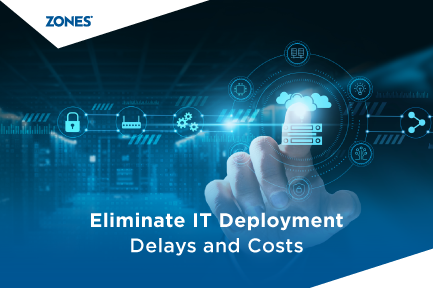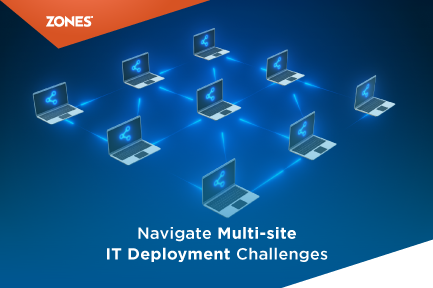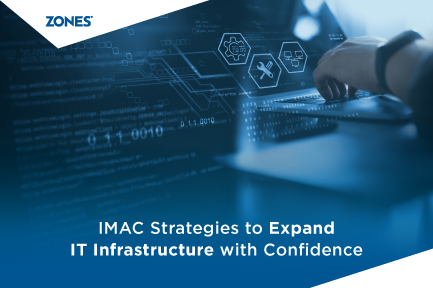8 Multi-site IT Deployment Challenges & How to Solve Them
With the rising digital transformation, implementing new technologies across multiple locations is often the difference between thriving and merely...
5 min read
![]() Zones
:
Oct 7, 2025 9:55:10 AM
Zones
:
Oct 7, 2025 9:55:10 AM

Picture this scenario: Your company is ready to launch a new office, expand operations, or refresh aging IT infrastructure. The timeline is tight, stakeholders are watching, and employee productivity hangs in the balance. Then reality hits – traditional IT deployments often involve weeks of manual setup, countless configuration hours, unexpected compatibility issues, and the inevitable downtime that brings business operations to a crawl.
For many organizations, IT deployments have become synonymous with operational disruption. Employees wait days or weeks for fully functional workstations, IT teams are overwhelmed with repetitive setup tasks, and the cumulative cost of delayed productivity can reach thousands of dollars per employee. In today's fast-paced business environment, this approach isn't just inefficient – it's unsustainable.
The complexity of modern IT ecosystems compounds these challenges. Organizations today manage hybrid cloud environments, multiple software platforms, security compliance requirements, and diverse device types across global locations. Each variable introduces potential failure points that can derail even the most carefully planned deployments.
|
Download White Paper: Seamless IT Rollouts Across Industries: Driving Business Expansion |
Modern businesses operate in an always-on economy where downtime directly translates to lost revenue, reduced productivity, and frustrated employees. The need for zero-downtime deployment has become a business necessity, requiring seamless IT deployments without interrupting existing operations or delaying new initiatives.
Besides the operational imperative, cost-effectiveness remains paramount. Companies are constantly pressured to optimize IT spending while maintaining high service levels. The traditional approach of purchasing hardware, manually configuring devices, and deploying through lengthy setup processes no longer aligns with modern business demands for agility and efficiency. Additionally, there are several factors that drive the need for zero-downtime and cost-effective IT deployments:
As organizations become increasingly digital, the dependency on IT infrastructure grows exponentially. A single hour of downtime during a deployment can cascade into customer service disruptions, sales pipeline interruptions, and compliance violations.
Markets move faster than ever, and organizations that can rapidly deploy new capabilities gain significant competitive advantages. Effective device deployment can lead to cost savings in the long run, as it minimizes the need for constant repairs and replacements, while ensuring business continuity during critical growth phases.
The modern workforce expects enterprise technology to work as seamlessly as consumer devices. Lengthy setup processes and deployment-related downtime directly impact employee satisfaction, retention, and productivity.
Beyond the obvious downtime costs, inefficient deployments create hidden expenses through IT resource allocation, extended project timelines, and opportunity costs associated with delayed business initiatives.
|
Related Blog: |
The solution to zero-downtime and cost-effective IT deployment lies in strategic methodologies that eliminate disruptions while reducing overall costs through streamlined processes, pre-configuration services, and expert delivery coordination.
Here are the key steps to ensure zero-downtime IT deployment in a cost-effective manner.
Successful zero-downtime deployment begins long before devices arrive at your location. Your organization must thoroughly assess your current infrastructure, user requirements, and deployment constraints. This planning phase should include defining rollback strategies and conducting thorough testing before deploying to production:
Creating standardized, repeatable configuration processes eliminates the variability that often leads to deployment delays and downtime. This involves:
Effective asset management extends beyond simple tracking to encompass the entire lifecycle of IT assets throughout the deployment process.
|
Related Blog: Asset Tagging 101: A Guide to Tracking Your IT Hardware Efficiently |
Intelligent packaging strategies can dramatically reduce deployment complexity and time-to-productivity.
The final deployment phase requires precise coordination and execution to ensure a seamless user experience.
|
Related Blog: |
Organizations implementing comprehensive zero-downtime deployment strategies should track specific metrics to validate success and identify optimization opportunities:
Zones dedicated IT Rollout Services exemplify how organizations can achieve true zero-downtime deployment while reducing costs. Through our Technology Solution Centers (TSCs), we offer a comprehensive approach that addresses every aspect of IT deployment challenges.
|
Download Brochure: |
Zones Zero-touch deployment transforms traditional IT rollouts by delivering fully configured, deployment-ready devices with custom OS and security configurations, pre-loaded applications, professional asset tagging and kitting, plus global delivery coordination. This approach accelerates customer time-to-productivity by 30%, reducing deployment timelines from weeks to hours.
White glove delivery services address distribution complexity through custom kitting solutions, office-in-a-box deployments, boxless delivery options, and tailored packaging solutions that eliminate unpacking requirements while supporting sustainability goals.
Zero downtime deployment represents more than avoiding operational disruption – it transforms IT deployments from business bottlenecks into competitive advantages. Success in zero-downtime deployment ultimately depends on viewing IT deployment as a comprehensive business capability rather than a technical task. However, deployment excellence requires combining strategic planning, advanced technologies, standardized processes, and often, partnership with specialized service providers who possess the expertise and infrastructure necessary for complex, global deployments.
Ready to revolutionize your IT deployments?
Contact Zones today to schedule a Technology Solution Center tour and discover how Zero-Touch Deployment and White Glove Delivery services can accelerate your organization's time-to-productivity while reducing deployment costs.

With the rising digital transformation, implementing new technologies across multiple locations is often the difference between thriving and merely...

Picture this: It's Monday morning! Your organization’s IT ticket system has been flooded with service tickets. Sarah from Marketing needs her laptop...

Today, accelerating globalization, market demands, and competition drive companies' expansion and utilization of multiple offices across cities,...